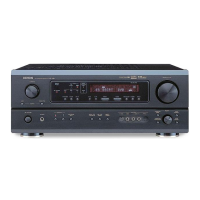SIGNAL
DIGITAL
DIGITAL
DIGITAL
SIGNAL
SIGNAL
20
ENGLISH
3
Select the play mode.
Press the SURROUND MODE button, then turn
the SELECT knob.
The volume can be adjusted within the
range of –70 to 0 to 18 dB, in steps of 1 dB.
However, when the channel level is set as
described on page 23, if the volume for any
channel is set at +1 dB or greater, the
volume cannot be adjusted up to 18 dB. (In
this case the maximum volume is adjusted
to “18 dB — (Maximum value of channel
level)”.)
Input mode when playing DTS sources
• Noise will be output if DTS-compatible CDs or LDs
are played in the “ANALOG” or “PCM” mode.
When playing DTS-compatible sources, be sure to
connect the source component to the digital input
jacks (OPTICAL/COAXIAL) and set the input mode to
“DTS”.
4
Start playback on the selected component.
• For operating instructions, refer to the
component’s manual.
5
Adjust the volume.
(Main unit)
(Remote control
unit)
The volume level
is displayed on
the master
volume level
display.
To select the surround mode
while adjusting the surround
parameters, tone defeat or tone
control, press the surround mode
button then operate the selector.
(Main unit) (Remote control unit)
Input mode display
ANALOGDIGITAL
DIGITAL
DIGITAL
ANALOG
AUTO
PCM
DTS
INPUT
AUTO
PCM
DTS
INPUT
AUTO
PCM
DTS
INPUT
AUTO
PCM
DTS
INPUT
• In the AUTO mode
• In the DIGITAL PCM mode
• In the DIGITAL DTS mode
• In the ANALOG mode
One of these lights,
depending on the input
signal.
Input signal display
• DOLBY DIGITAL
• DTS
• PCM
The indicator lights when digital signals
are being input properly. If the indicator
does not light, check whether the digital input
component setup (page 14) and connections are
correct and whether the component’s power is
turned on.
DIGITAL
DIGITAL
NOTE:
• The indicator will light when playing
CD-ROMs containing data other than audio
signals, but no sound will be heard.
DIGITAL
NOTE:
• Note that noise will be output when CDs or LDs
recorded in DTS format are played in the “PCM”
(exclusive PCM signal playback) or “ANALOG”
(exclusive PCM signal playback) mode. Select the
AUTO or DTS mode when playing signals recorded
in DTS.
Notes on playing a source encoded with DTS
• Noise may be generated at the beginning of
playback and while searching during DTS
playback in the AUTO mode. If so, play in the
DTS mode.
•
In some rare cases the noise may be generated
when you preform the operation to stop
playback of a DTS-CD or DTS-LD.
Example: Stereo
(Main unit)
Playback using the external input (EXT. IN) jacks
(Main unit) (Remote control unit)
1
Set the external input (EXT. IN) mode.
Press the EXT. IN to switch the external input.
2
Cancelling the external input mode
To cancel the external input (EXT. IN) setting,
press the INPUT MODE (AUTO, PCM, DTS) or
ANALOG button to switch to the desired input
mode. (See page 19.)
(Main unit) (Remote control unit)
Once this is selected, the input signals
connected to the FL (front left), FR (front right),
C (center), SL (surround left), and SR (surround
right) channels of the EXT. IN jacks are output
directly to the front (left and right), center,
surround (left and right) speaker systems
without passing through the surround circuitry.
In addition, the signal input to the SW
(subwoofer) jack is output to the PRE OUT
SUBWOOFER jack.
• When the input mode is set to the external input
(EXT. IN), the play mode (DIRECT, STEREO,
DOLBY/DTS SURROUND, 5CH/6CH STEREO or
DSP SIMULATION) cannot be selected.
21
NOTES:
• In play modes other than the external input
mode, the signals connected to EXT. IN jacks
cannot be played. In addition, signals cannot be
output from channels not connected to the input
jacks.
• The external input mode can be set for any input
source. To watch video while listening to sound,
select the input source to which the video signal
is connected, then set this mode.
• If the subwoofer output level seems to high, set
the “SW ATT.” surround parameter to “ON”.

